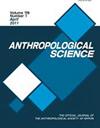The Ibaloi fire mummies: the art and science of mummification in the Philippines
IF 0.8
4区 社会学
Q3 EVOLUTIONARY BIOLOGY
引用次数: 1
Abstract
The Ibaloi fire mummies are preserved ancient remains of Ibaloi, one of the indigenous peo ples of the northern Philippines. The locals kept the traditional Ibaloi mummification through oral tradi -tions, but the current generation no longer conducts the actual practice. We categorized the mummifica tion steps into preprocessing, smoking, and postprocessing. The preprocessing involved a ‘saltwater purge,’ washing, positioning the body onto a ‘death chair,’ removing the epidermis, and ‘deworming.’ The smoking process, from which the name ‘fire mummy’ was derived, involved the smoking of a body under a low-lit woodfire. The postprocessing involved sun-drying and application of a plant concoction to the body. Notably, the traditional Ibaloi mummification process shares similarities with other mummi fication practices elsewhere. This paper provides a systematic review of the traditional Ibaloi mummifi cation and highlights the essential physical and chemical processes involved in body preservation. We want to encourage more interdisciplinary studies on the Ibaloi fire mummies to identify potential appli cations of the traditional process in corpse preservation. We also hope to contribute to discourses with people from multicultural backgrounds to increase our understanding of the history and culture of an cient human settlements in the Philippines and the Asia-Pacific.伊巴洛伊火木乃伊:菲律宾木乃伊制作的艺术和科学
伊巴洛伊火木乃伊是伊巴洛伊人保存下来的古代遗迹,伊巴洛伊人是菲律宾北部土著民族之一。当地人通过口头传统保留了伊巴洛伊人制作木乃伊的传统,但现在这一代人不再进行实际的实践。我们将木乃伊化的步骤分为预处理、熏制和后处理。预处理过程包括“盐水清洗”、清洗、将尸体放在“死亡椅”上、去除表皮和“驱虫”。“火木乃伊”这个名字就是由此而来的,它指的是在昏暗的柴火下把尸体熏成烟。后处理包括晒干和将植物混合物应用于身体。值得注意的是,传统的伊巴洛伊木乃伊制作工艺与其他地方的木乃伊制作工艺有相似之处。本文提供了一个系统的回顾,传统的伊巴洛伊人的木乃伊,并强调了必要的物理和化学过程中涉及的身体保存。我们希望鼓励对伊巴洛伊火木乃伊进行更多的跨学科研究,以确定传统方法在尸体保存中的潜在应用。我们也希望与来自多元文化背景的人进行对话,以增加我们对菲律宾和亚太地区古代人类住区的历史和文化的了解。
本文章由计算机程序翻译,如有差异,请以英文原文为准。
求助全文
约1分钟内获得全文
求助全文
来源期刊

Anthropological Science
生物-进化生物学
CiteScore
1.50
自引率
0.00%
发文量
7
审稿时长
>12 weeks
期刊介绍:
Anthropological Science (AS) publishes research papers, review articles, brief communications, and material reports in physical anthropology and related disciplines. The scope of AS encompasses all aspects of human and primate evolution and variation. We welcome research papers in molecular and morphological variation and evolution, genetics and population biology, growth and development, biomechanics, anatomy and physiology, ecology and behavioral biology, osteoarcheology and prehistory, and other disciplines relating to the understanding of human evolution and the biology of the human condition.
 求助内容:
求助内容: 应助结果提醒方式:
应助结果提醒方式:


